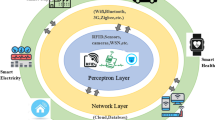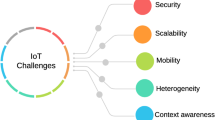Abstract
The way to compare the efficiencies of different detect strategies (DSs) in the “ping-pong” protocol is studied. The trade-off between information gain and disturbance is calculated and compared for different DSs. The comparison result primely tallies with our intuitional analysis. It is shown that the analysis of this trade-off is a feasible way to compare the performances of different DSs in theory.
Similar content being viewed by others
References
Vernam G S. Cipher printing telegraph systems for secret wire and radio telegraphic communications. J Am Inst Elect Eng, 1926, 55: 109–115
Shannon C E. Communication theory of secrecy systems. Bell Syst Technol J, 1949, 28: 656–715
Bennett C H, Brassard G. Quantum cryptography: Public-key distribution and coin tossing. In: Proceedings of IEEE International Conference on Computers, Systems and Signal Processing. Bangalore: IEEE press, 1984. 175–179
Ekert A K. Quantum cryptography based on Bell’s theorem. Phys Rev Lett, 1991, 67: 661–663
Bennett C H. Quantum cryptography using any two nonorthogonal states. Phys Rev Lett, 1992, 68: 3121–3124
Gisin N, Ribordy G, Tittel W, et al. Quantum cryptography. Rev Mod Phys, 2002, 74: 145–195
Bostrom K, Felbinger T. Deterministic secure direct communication using entanglement. Phys Rev Lett, 2002, 89: 187902
Deng F G, Long G L. Secure direct communication with a quantum one-time pad. Phys Rev A, 2004, 69: 052319
Cai Q Y, Li B W. Deterministic secure communication without using entanglement. Chin Phys Lett, 2004, 21: 601–603
Lucamarini M, Mancini S. Secure deterministic communication without entanglement. Phys Rev Lett, 2005, 94: 140501
Deng F G, Long G L, Liu X S. Two-step quantum direct communication protocol using the Einstein-Podolsky-Rosen pair block. Phys Rev A, 2003, 68: 042317
Cai Q Y, Li B W. Improving the capacity of the Bostrom-Felbinger protocol. Phys Rev A, 2004, 69: 054301
Gao T, Yan F L, Wang Z X. A simultaneous quantum secure direct communication scheme between the central party and other M parties. Chin Phys Lett, 2005, 22: 2473–2476
Wang C, Deng F G, Li Y S, et al. Quantum secure direct communication with high-dimension quantum superdense coding. Phys Rev A, 2005, 71: 044305
Wang C, Deng F G, Long G L. Multi-step quantum secure direct communication using multi-particle Green-Horne-Zeilinger state. Opt Commun, 2005, 253: 15–20
Li X H, Deng F G, Zhou H Y. Improving the security of secure direct communication based on the secret transmitting order of particles. Phys Rev A, 2006, 74: 054302
Li X H, Li C Y, Deng F G, et al. Quantum secure direct communication with quantum encryption based on pure entangled states. Chin Phys, 2007, 16: 2149–2153
Nguyen B A. Quantum dialogue. Phys Lett A, 2004, 328: 6–10
Man Z X, Zhang Z J, Li Y. Quantum dialogue revisited. Chin Phys Lett, 2005, 22: 22–24
Ji X, Zhang S. Secure quantum dialogue based on single-photon. Chin Phys, 2006, 15: 1418–1420
Man Z X, Xia Y J, Nguyen B A. Quantum secure direct communication by using GHZ states and entanglement swapping. J Phys B: At Mol Opt Phys, 2006, 39: 3855–3863
Man Z X, Xia Y J. Controlled bidirectional quantum direct communication by using a GHZ state. Chin Phys Lett, 2006, 23: 1680–1682
Xia Y, Fu C B, Zhang S, et al. Quantum dialogue by using the GHZ state. J Korean Phys Soc, 2006, 48: 24–27
Jin X R, Ji X, Zhang Y Q, et al. Three-party quantum secure direct communication based on GHZ states. Phys Lett A, 2006, 354: 67–70
Man Z X, Xia Y J. Improvement of security of three-party quantum secure direct communication based on GHZ states. Chin Phys Lett, 2007, 24: 15–18
Chen Y, Man Z X, Xia Y J. Quantum bidirectional secure direct communication via entanglement swapping. Chin Phys Lett, 2007, 24: 19–22
Yang Y G, Wen Q Y. Quasi-secure quantum dialogue using single photons. Sci China Ser G-Phys Mech Astron, 2007, 50(5): 558–562
Gao F, Guo F Z, Wen Q Y, et al. Revisiting the security of quantum dialogue and bidirectional quantum secure direct communication. Sci China Ser G-Phys Mech Astron, 2008, 51(5): 559 566
Gao F, Qin S J, Wen Q Y, et al. Comment on: “Three-party quantum secure direct communication based on GHZ states”. Phys Lett A, 2008, 372: 3333–3336
Tan Y G, Cai Q Y. Classical correlation in quantum dialogue. Int J Quantum Inf, 2008, 6: 325–329
Wojcik A. Eavesdropping on the “Ping-Pong” quantum communication protocol. Phys Rev Lett, 2003, 90: 157901
Deng F G, Li X H, Li C Y, et al. Eavesdropping on the “ping-pong” quantum communication protocol freely in a noise channel. Chin Phys, 2007, 16: 277–281
Cai Q Y. The “Ping-Pong” protocol can be attacked without eavesdropping. Phys Rev Lett, 2003, 91: 109801
Zhang Z J, Man Z X. The improved Bostrom-Felbinger protocol against attacks without eavesdropping. Int J Quantum Inf, 2004, 2: 521–527
Hoffmann H, Bostroem K, Felbinger T. Comment on “Secure direct communication with a quantum one-time pad”. Phys Rev A, 2005, 72: 016301
Deng F G, Long G L. Reply to “Comment on ‘secure direct communication with a quantum one-time pad’”. Phys Rev A, 2005, 72: 016302
Deng F G, Li X H, Li C Y, et al. Quantum secure direct communication network with Einstein-Podolsky-Rosen pairs. Phys Lett A, 2006, 359: 359–365
Hillery M, Bužek V, Berthiaume A. Quantum secret sharing. Phys Rev A, 1999, 59: 1829–1834
Cleve R, Gottesman D, Lo H-K. How to share a quantum secret. Phys Rev Lett, 1999, 83: 648–651
Bennett C H, Brassard G, Mermin N D. Quantum cryptography without Bell theorem. Phys Rev Lett, 1992, 68: 557–559
Gao F, Guo F Z, Wen Q Y, et al. Quantum key distribution without alternative measurements and rotations. Phys Lett A, 2006, 349: 53–58
Author information
Authors and Affiliations
Corresponding author
Additional information
Supported by the National High Technology Research and Development Program of China (Grant No. 2006AA01Z419), the National Natural Science Foundation of China (Grant Nos. 90604023 and 6087319), the National Laboratory for Modern Communications Science Foundation of China (Grant No. 9140C1101010601), the Natural Science Foundation of Beijing (Grant No. 4072020), and the ISN Open Foundation.
Rights and permissions
About this article
Cite this article
Gao, F., Guo, F., Wen, Q. et al. Comparing the efficiencies of different detect strategies in the ping-pong protocol. Sci. China Ser. G-Phys. Mech. Astron. 51, 1853–1860 (2008). https://doi.org/10.1007/s11433-008-0185-4
Received:
Accepted:
Published:
Issue Date:
DOI: https://doi.org/10.1007/s11433-008-0185-4




